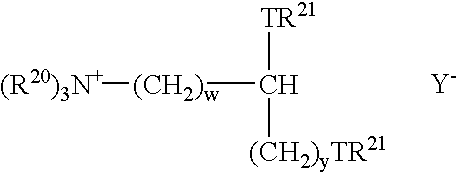Polymers for laundry cleaning compositions
a technology of polymer and composition, applied in the field of block copolymers, can solve the problems of high density of cationic positive changes on the polymer, incompatibility of anionic surfactants in laundry washing compositions, and inability to include benefit agents in compositions,
- Summary
- Abstract
- Description
- Claims
- Application Information
AI Technical Summary
Benefits of technology
Problems solved by technology
Method used
Image
Examples
examples 1 to 5
ABA Triblock Copolymers of the Following General Formula:
[0174]
in which m and n are positive integers
[0175]were prepared by atom transfer radical polymerisation (ATRP). Commercially available poly(ethylene glycol)s were halide functionalised to give an effective ATRP initiator. Controlled molecular weights were achieved with narrow polydispersities.
Experimental procedures for the Preparation of PDMAEMA-PEG-PDMAEMA-Block Copolymers
(A) Preparation of Poly(ethylene Glycol) (PEG) Macroinitiator
[0176]Poly(ethylene glycol), MW=1000, ex Polysciences Inc. (20 g, 0.02 moles) was dissolved in anhydrous toluene (100 ml) in a 2-necked round bottom flask fitted with a suba seal and calcium chloride guard tube. 4-(Dimethylamino)pyridine (DMAP) (0.054 g, 4.4×10−4 moles), triethylamine (TEA) (4.45 g, 0.044 moles) and a magnetic stirrer bar were added to the PEG solution. 2-Bromoisobutyryl bromide (10.12 g, 0.044 moles) was added dropwise via a syringe through the suba seal, which caused the initial...
example 6
Soil Release Evaluation
[0190]The polymers of Examples 1 to 5 were tested for detergency on cotton fabric using an apparatus for simultaneously contacting different liquids with different regions of a single sheet of fabric. This apparatus is described in detail in U.S. patent application Ser. No. 09 / 593,730, filed Jun. 13, 2000, which is incorporated herein by reference. Briefly, the fabric sheet was clamped between an upper and lower block. The fabric sheet was sandwiched between two rubber seals. Both blocks and seals contain an 8×12 array of square cavities, which are aligned. When blocks and fabrics are clamped together, liquids placed in individual wells do not leak or bleed through to other wells, due to the pressure applied by the blocks in the regions separating the wells. The liquids are forced to flow back and forth through the fabric by means of a pneumatically actuated thin rubber membrane, which is placed between the fabrics and the lower block. Repeated flexing of the ...
example 7
Preparation of a PEG-PDMAEMA A-B Block Copolymer
(A) Preparation of Poly(Ethylene Glycol) (PEG) Macroinitiator
[0199]Monomethoxy poly(ethylene glycol), MW=5000, ex Aldrich (50 g, 0.01 moles) was dissolved in anhydrous toluene (250 ml) in a 2-necked round bottom flask fitted with a suba seal and calcium chloride guard tube. Polymer-bound 4-(dimethylamino)pyridine (2 g, 1.25 mmol N / g), triethylamine (2.02 g, 0.02 moles) and a magnetic stirrer bar were added to the PEG solution. 2-Bromoisobutyryl bromide (4.6 g, 0.02 moles) was added dropwise via a syringe through the suba seal, which caused the initially clear solution to turn to a milky suspension. After stirring at ambient temperature overnight, the reaction mixture was filtered through a bed of silica to remove insolubles. The filtrate was evaporated to about one third of its original volume, then added to petroleum ether and the precipitated product collected on a filter. After drying overnight under vacuo the product was obtained a...
PUM
| Property | Measurement | Unit |
|---|---|---|
| Molecular weight | aaaaa | aaaaa |
| Polydispersity index | aaaaa | aaaaa |
Abstract
Description
Claims
Application Information
 Login to View More
Login to View More - R&D
- Intellectual Property
- Life Sciences
- Materials
- Tech Scout
- Unparalleled Data Quality
- Higher Quality Content
- 60% Fewer Hallucinations
Browse by: Latest US Patents, China's latest patents, Technical Efficacy Thesaurus, Application Domain, Technology Topic, Popular Technical Reports.
© 2025 PatSnap. All rights reserved.Legal|Privacy policy|Modern Slavery Act Transparency Statement|Sitemap|About US| Contact US: help@patsnap.com



